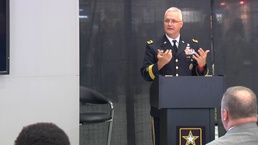
To better support its vision is to sustain Army readiness and support modernization, Army Contracting Command’s commanding general said the organization will reimagine itself.
“The number one things we spend our time talking about is readiness and modernization and how any effort we do within Army Contracting Command is tied directly to that, but that takes an engagement with industry,” said Maj. Gen. Paul Pardew.
Pardew outlined Army Contracting Command’s priorities and initiatives during a Warriors Corner presentation at the Association of the United States Army Annual Meeting in Washington D.C. on Oct. 9.
To start, Pardew gave an overview of Army Contracting Command and its reform efforts. In fiscal 2018, the command awarded 151,400 actions valued at approximately $69 billion including contracts, other transaction authority and grants/agreements. Right now, Pardew said the average time it takes to put a contract in place is 170 days. The acquisition lead time, Pardew said, is a part of the reform discussion.
Among other reform initiatives, Army Contracting Command has built a data analytics cell to help see itself, how contracts are used and if more strategic sources are available. Also, Pardew outlined the organization’s use of other transaction authorities.
“My responsibility as the Army Contracting Command commander is to make sure that what authorities we’ve been given with other transaction authorities stay within those authorities,” said Pardew. “While it’s a very quick way to prototype, very quick way to bring consortia and nonstandard players to the game, we can’t get outside those authorities because Congress is watching us. If we get outside of the box on this, that tool will be taken away.”
Pardew said every other transaction authority is unique and each takes time to negotiate, especially with nontraditional vendors. He mentioned draft other transaction authorities are a useful tool, and with the industry’s help, it can help the process improve.
“When ground combat vehicle or any other of these Army Futures Command efforts come out, it’s really important for you all to give us feedback because otherwise that solicitation may go out as something that is not executable,” said Pardew. “The feedback on these drafts are critically important to how we’re going forward.”
One of Army Contracting Command’s top priorities, supported by Army Materiel Command’s commander, Gen. Gus Perna, is working with the Army’s newest command, Army Futures Command. Pardew said four to five contracting specialists from Army Contracting Command are now working at a headquarters cell within Army Futures Command. In addition, he said two contracting officers from Army Contracting Command’s contracting centers are now aligned to each cross-functional team.
“Those two people who are aligned to the cross-functional teams will help take Army Futures Command’s visions and translate it into something that the centers can get on contract,” Pardew said.
Another priority is de-obligation of funds. Pardew said the Army has contracts with money sitting on them across multiple years. For example, he said in fiscal 2018, the command ran through all unliquidated obligations so the money could be returned and used more efficiently. He said Army Contracting Command returned $125 million to the Army.
“The Army has contracts that have money sitting on them across multiple years,” said Pardew. “We are now chasing those dollars down to return them to the Army. If you listen to anything the Secretary of the Army said in the past two days, we’ve got to make sure we’re using every nickel appropriately.”